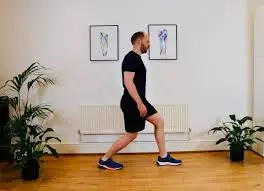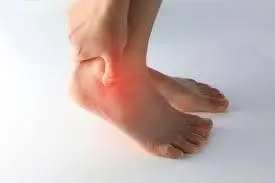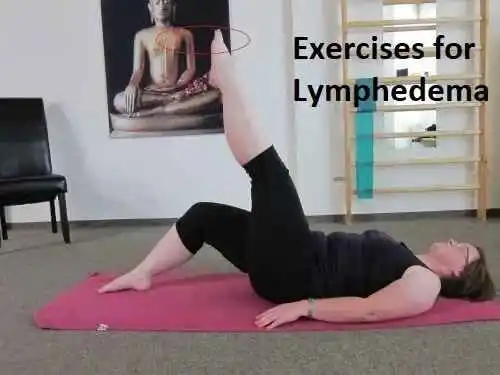13 Best Exercises For Achilles Tendon Tear
Introduction:
An Achilles tendon tear is a serious injury that affects the tendon connecting your calf muscles to your heel bone. Recovery involves targeted exercises that gradually restore strength, flexibility, and mobility. The right rehabilitation program plays a crucial role in healing and preventing future injuries.
The largest and strongest tendon in the body, the Achilles tendon, joins the soleus and gastrocnemius muscles of the calf to the heel bone. Walking, jogging, and everyday movement can all be severely affected by an Achilles tendon tear, which is a dangerous condition. Exercises for Achilles Tendon Tear have become essential for restoring strength, flexibility, and function, regardless of whether the condition is treated medically or non-surgically.
There are two types of Achilles tendon tears: partial and full. The severity of the rupture determines the symptoms. A rapid and total rupture is the most prevalent kind, particularly in sportsmen or others who engage in sudden physical activity.
Whether treated conservatively or surgically, exercise is an essential component of healing following an Achilles tendon injury. Numerous long-term, functional, and physical advantages can be achieved through carefully designed exercises for rehabilitation.
Causes:
Extended Use and Prolonged Tendinopathy
- Degenerative alterations in the tendon, known as Achilles tendinosis, can result from repeated microtrauma caused by overuse, which is frequent in runners.
- Even a slight force is more likely to tear a weak, chronically irritated tendon.
Degeneration Associated with Age
- Most Achilles tendon ruptures happen to adults between the ages of 30 and 50.
- With aging, the tendon becomes less elastic and stronger, making it more susceptible to damage.
- In particular, weekend sports and unfamiliar activities put older persons at risk.
Unexpected Rise in Force or Stress
- When engaging in activities that demand quick stops, starts, or direction changes, the majority of Achilles tears happen.
Typical in sports like as:
- Basketball
- Tennis
- Football
- Sprinting or jumping events
The tendon may rupture as a result of these activities’ sudden and severe strain.
Utilization of Specific Medications
- Antibiotics that include fluoroscopy antibiotics, such as ciprofloxacin and levofloxacin, are linked to a higher risk of tendon rupture.
- The Achilles tendon’s structure may be weakened by corticosteroid injections administered in or close to it.
- Long-term usage of statins or oral corticosteroids may potentially be a factor.
Biomechanical Issues
- Unusual stresses on the tendon may result from high arches or flat feet (overpronation).
- Incorrect footwear or differences in leg length might also raise the risk of injury.
Trauma
- Rupture may result from a direct injury to the Achilles tendon, such as a fall or accident.
- In rare cases, a tear can also result from cuts or wounds to the rear of the ankle.
Lack of flexibility or conditioning
- Increased strain on the tendon might result from tight calf muscles or improper warm-up and stretching.
- When unconditioned people engage in sudden, high-intensity physical exercise, injuries frequently happen.
Signs and symptoms:
The symptoms of an Achilles tendon tear (rupture) are described in depth below, along with how they usually appear.
Sharp, Unexpected Pain
- Just above the heel (lower calf/posterior ankle).
“Pop” or “Snap” on sound.
- At the time of rupture, many people say they heard or felt a “pop” or “snap.”
- This sound is the result of the tendon fibers rupturing.
Having trouble walking or carrying weight
- Most people are unable to walk normally.
- The affected leg may limp or be incapable of supporting weight.
- Walking uphill or climbing stairs becomes quite challenging.
Plantar Flexion Weakness
Patients have difficulty or are unable to:
- On the damaged leg, stand on your tiptoes.
- Walking, push off the foot.
Observable Tendon Gap
- In a full tear, a space (2–6 cm) where the tendon has torn may be felt directly above the heel.
- It feels best when the patient is in the prone position, which involves lying face down with their feet dangling over the side of the table.
Inflammation and bruising
- Usually, swelling develops rapidly following the injury and is centered around the lower leg and heel.
- Bruising might appear on the foot and leg and spread in a matter of hours or days.
Advantages of exercise:
Restores function and strength.
- Exercises build strength in the soleus and gastrocnemius muscles, which are the calf muscles that are connected to the Achilles tendon.
- Restores the capacity of performing our motions like sprinting, jumping, walking, and climbing stairs.
Encourages Tendon Repair
- Collagen fiber alignment, which is essential for tendon strength and flexibility, is stimulated by gradually stressing the tendon with certain activities.
- Increased blood flow from exercise supports tissue regeneration by delivering vital nutrients to the injured area.
Stop Muscle Atrophy
- Calf muscle atrophy results from prolonged inactivity.
- Muscle healing and neuromuscular coordination are improved by strength exercise.
Minimizes adhesions and scar tissue
- Internal adhesions, which can restrict mobility and result in persistent pain, are reduced by gradual, gentle movement.
Balance and Proprioception Are Improved
- Exercises for rehabilitation involve stability and balance training to retrain the body’s sense of joint position.
- Vital for avoiding falls or sprained ankles during recuperation.
Lowers Re-Injury Risk
- A tendon that is strong, flexible, and well-conditioned is less likely to tear later on.
- To lessen tendon stress, balance and neuromuscular training promote proper body mechanics.
Increases Flexibility and Range of Motion
- Ankle stiffness following a tear is frequently caused by inflammation and immobility.
- Exercises for mobility and stretching help in restoring normal plantarflexion and dorsiflexion, or upward and downward foot movement.
Over Time, It Encourages Joint Health
- Over time, arthritis, joint stiffness, and chronic inflammation can be avoided by maintaining an active ankle joint.
Exercises For Achilles Tendon Tear:
Ankle pump
- Begin by lying down on a bed.
- Make sure your toes are pointed upward by flexing them.
- Hold this position for a few seconds.
- As though you were pressing down on a car’s gas pedal, point your toes forward.
- Hold this position for a few seconds.
- Then return to your neutral position.
- Then relax.
- Repeat these exercises 5 to 10 times.
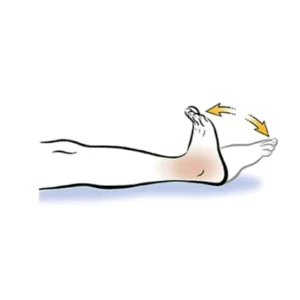
Standing calf stretch
- Place yourself at arm’s length from a wall or stable exercise equipment.
- Place your hands flat on the wall.
- Maintain a straight knee and a flat heel on the ground while extending one leg.
- Move your hips forward and bend your elbows and front knee gradually until your calf feels stretched.
- Hold this position for a few seconds.
- Then return to your neutral position.
- Then relax.
- Repeat these exercises 5 to 10 times.
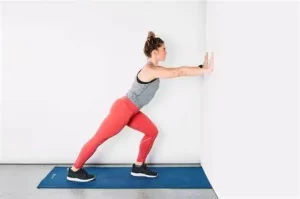
Toe curls
- Spread the towel out and then place a flat foot on it.
- The towel will be moved towards you, so place extra fabric in front of your foot.
- Flex your foot back and raise your toes while maintaining a low heel.
- Get your foot as far out on the towel as you can while keeping your heel on it by reaching out equally along the sides and the middle of your foot.
- Pull the towel in towards you with your foot arch while maintaining heel stability.
- The more you draw back and extend, the less of the towel you will have to move.
- It may be necessary to pause after a few repetitions to spread the cloth again.
- Then return to your neutral position.
- Then relax.
- Repeat these exercises 5 to 10 times.
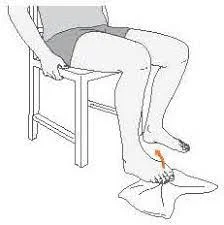
Calf raise
- While gripping the back of a chair, stand up on the ground.
- Exhale and stand up on your toes, focusing on maintaining balance while keeping your legs straight.
- Till you are unable to stand any higher on your toes, keep lifting yourself.
- Hold this position for a few seconds.
- Take a breath and drop back down to where you were before.
- Then return to your neutral position.
- Then relax.
- Repeat these exercises 5 to 10 times.
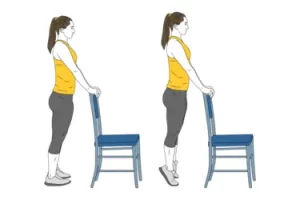
Seated heel raise
- Place your feet flat on the ground and sit on a stable chair or bench.
- Put your hands on your thighs to help you stay balanced.
- With your calves contracting, push into the heel of your feet and raise your heels as high off the ground as you can.
- Hold this position for a few seconds.
- Return your heels to the floor slowly while maintaining control of the movement.
- Then return to your neutral position.
- Then relax.
- Repeat these exercises 5 to 10 times.
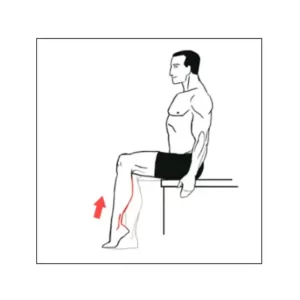
Standing heel raise
- Start with a standing position on the floor.
- For balance and support, place your hand on the backrest.
- Inhale and turn the foot so that the toes point in opposite directions.
- Breathe out and lift your heels off the floor.
- Hold this position for a few seconds.
- Breathe deeply and plant your heels on the floor.
- Then return to your neutral position.
- Then relax.
- Repeat these exercises 5 to 10 times.

Towel stretch
- Start with a seating position on the floor.
- Next, extend your legs out.
- Using your hands to grip both sides of the towel, loop it around one foot.
- Pull your toes gently towards your shin until your calf starts to stretch.
- Hold this position for a few seconds.
- Then return to your neutral position.
- Then relax.
- Repeat these exercises 5 to 10 times.
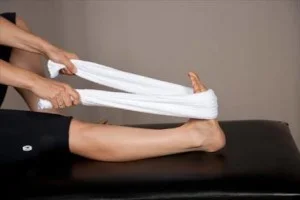
Ankle alphabet
- Take a seat in a comfortable chair or couch.
- Stretch your leg out and create the letters of the alphabet in the air with your big toe.
- The ankle can be moved in all directions with this easy workout.
- Then return to your neutral position.
- Then relax.
- Repeat these exercises 5 to 10 times.
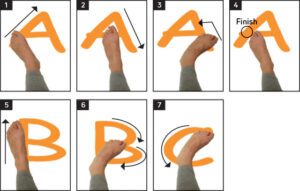
Toe-to-wall stretch
- You should be facing a wall.
- Take a split stance, placing one foot close to the wall and one back.
- For stability, place your palms against the wall.
- Place your front foot close to the wall and keep your toes against it.
- Place your weight on your front foot to feel the stretch throughout your front leg’s bottom portion.
- Hold this position for a few seconds.
- Then return to your neutral position.
- Then relax.
- Repeat these exercises 5 to 10 times.

Eccentric heel drop
- Just your toes should be supported as you stand on a stair.
- Utilise the wall or railing for stability.
- Elevate yourself with your good leg.
- Your good leg should be moved to the side that hurts.
- Let your heel drop as far as it can while keeping your knee straight.
- After that, flex your knee to gain a bit more flexibility.
- Hold this position for a few seconds.
- Return to the starting posture on your tiptoes by pushing yourself with the good leg.
- Then return to your neutral position.
- Then relax.
- Repeat these exercises 5 to 10 times.
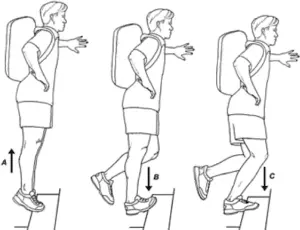
Straight leg raise
- Begin by lying on your back.
- Both legs are level on the ground, with one bent at the knee.
- Pay attention to maintaining your straight leg as you raise it towards the ceiling.
- Hold this position for a few seconds.
- Then return to your neutral position.
- Then relax.
- Repeat these exercises 5 to 10 times.
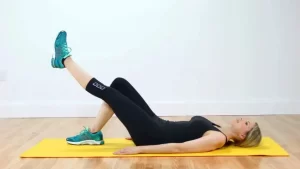
Single-leg balance
- Start by holding yourself up straight.
- Put one leg at the knee to elevate your foot behind you.
- Rise to your feet and use the other foot to balance.
- Hold this position for a few seconds.
- Lower the foot that was elevated.
- Then return to your neutral position.
- Then relax.
- Repeat these exercises 5 to 10 times.
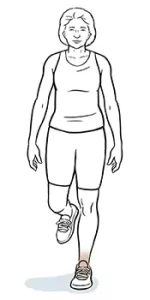
Tip-toe walking
- Choose a level, non-slip surface to stand on.
- An upright position should be adopted, with your shoulders relaxed and your arms at your sides or slightly extended for balance.
- Put your right foot directly in front of your left so that the heel of your right foot contacts the toes of your left.
- With caution, shift your weight forward onto your front foot.
- Move your left foot in the direction of your right foot from heel to toe to take a step forward.
- Support yourself with a wall, counter, or other strong object if needed.
- Then return to your neutral position.
- Then relax.
- Repeat these exercises 5 to 10 times.
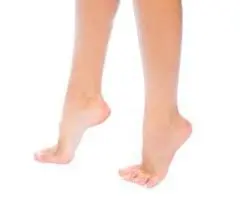
What precautions should be taken when exercising?
Exercise is essential for recovery from an Achilles tendon tear, but safety is also important in ensuring proper healing and avoiding re-injury.
Regardless of whether you are in the early, mid, or late healing period, the safety precautions you should take when performing rehabilitation exercises for an Achilles tendon injury are listed in depth below.
Warm up first, then cool down.
- Light warm-ups, such as ankle pumps or toe curls, should be performed before each session.
- If there is any swelling or pain, finish with ice and mild stretching.
Move Gradually
- Don’t go right into strengthening, stretching, or weight-bearing.
- Gradually increase complexity, length, and intensity (depending on pain and tolerance).
Prevent Pain While Working Out or After
- It’s common to have moderate soreness or some muscular tiredness.
- Red signs include pain that becomes worse with time, a “pop” sound, or sharp, stabbing pain.
- During or after the activity, pain shouldn’t get worse.
Pay Attention to Your Body
- Sharp pain, cracking, or swelling are warning indicators, although slight pain is OK.
- If you hear a “pop” or experience sudden pain while performing exercises, stop right away.
Make Good Use of Supportive Equipment
In the beginning:
- Wear a heel lift, ankle brace, or walking boot as directed.
- If you are not yet able to bear your weight, use a walker or crutches.
Put on Proper Footwear
Put on shoes with:
- Strong arch support
- Heels with cushions
- Non-slip soles
Work Out on Secure Surfaces
- Perform workouts on clean, level, non-slip surfaces.
- For workouts that require sitting or lying down, use a mat or towel.
Keep an eye on your tendons daily.
Following every session, look for:
- Swelling
- Warmth or redness
- A rise in pain
- Stiffness in the morning
Employ the Right Method
- Use thoughtful, slow motions for every exercise.
- Ask a therapist to review your form or use a mirror.
Keep yourself hydrated and get enough sleep.
- Hydrate yourself before, during, and following your workouts.
- Get enough sleep to help in the healing and rebuilding of muscles.
When did you quit working out?
Here’s a comprehensive guide on determining whether to stop or pause your Achilles tendon rupture rehabilitation exercises:
Sharp, Unexpected Pain
- A sudden, intense pain in the heel or back of the leg might indicate:
- Re-injury of the tendon
- Tear extension
A “Pop” or “Snapping” Feeling
- A re-rupture may be indicated if you hear or feel a snap, pop, or tear-like feeling.
Elevated Bruising or Swelling
- While mild swelling is common, swelling that gets worse, especially after several sessions, is cause for concern.
- It may be a sign of inflammation, misuse, or improper development.
Loss of Strength or Range of Motion During Exercise
- You may have a strain or re-injury if your foot or ankle suddenly feels weaker or stiffer.
- With your physical therapist, you should pause and reevaluate.
Foot drop, tingling, or numbness
- These symptoms might point to circulation problems or nerve involvement.
- Stop exercising and consult a doctor.
Constant Pain Following Exercise
- You’ve probably pushed too far if you have pain, stiffness, or swelling that persists for more than a day or two following a practice.
- Lower the intensity or go back to a more secure level.
Warmth or Redness Over the Tendon
This may indicate:
- Inflammation (bursitis or tendinitis)
- Infection (if following surgery)
The issue may get worse if you keep exercising.
Which exercises should be avoided if you have an Achilles tendon tear?
Certain movements must be avoided if you have an Achilles tendon tear, whether you are in the acute phase or recovering, to avoid worsening the injury, slowing the healing process, or even rupturing it again.
This comprehensive guide explains which workouts are dangerous, why they should be avoided, and when, if at all, they may be safely resumed under expert supervision.
Exercises Using Plyometric and Jumping
- Jump rope
- Box jumps
- Burpees
- Jump squats or lunges
- The Achilles tendon receives a powerful impact and unexpected force from them.
- Can lead to a re-tear, particularly during the initial and intermediate phases of recuperation.
Sprinting and Running
- Running, particularly on hard surfaces
- Running on a treadmill and hill sprints
- With every step, running places a great deal of strain on the Achilles.
- May, if started too soon, worsen inflammation or postpone tendon recovery.
Excessive Calf Raises (Early)
- Heavy resistance calf raises when sitting or standing
- Leg press machines with weighted heel lifts
- The recovering tendon may become overloaded if too much force is applied too soon.
- Resistance must be introduced gradually.
Exercises for Balance or Stability on Unstable Surfaces (Too Early)
- Balance on one leg using foam pads, BOSU balls, or wobble boards
- Early-stage balancing exercises for the damaged leg
- The surrounding muscles and tendons are not prepared to regulate instability and lateral movement.
- High chance of falls, strains, or ankle rolling.
Early Phase: Stair Climbing or Incline Walking
- Walking on an inclined treadmill
- Going on hikes
- Stair climbing repeatedly
- Increases the load on the Achilles by placing the foot in dorsiflexion, or with the toes up.
- The potential for healed fibers to lengthen or rip again.
Summary:
Anybody who has experienced an Achilles tendon rupture knows that it may be tragic as well as extremely painful. Your usual occupation and hobbies may be affected by an Achilles tendon, which could also make it challenging for you to walk normally.
Achilles tendon tears are difficult to recover from, but you may restore full function and strength with the correct training regimen and medical supervision. Long-term success depends on having patience, following the right approach, and concentrating on safe, scientifically supported rehabilitation exercises.
Exercise gets things moving, and when done correctly, it may safely return you to your typical level of activity and mobility. Additionally, exercising gives you control and may help you avoid Achilles tendon issues in the future.
FAQ:
Do I need to perform rehab exercises every day?
Every day, individuals can perform simple range-of-motion and flexibility exercises.
Three to four times a week, with rest days to allow for healing, one might perform strengthening activities.
A customized timetable will be created for you by your physical therapist.
Can I continue working out if I’m still in pain?
While some pain is acceptable, particularly in the beginning, severe pain, worsening soreness, or swelling following physical activity indicate warning signs.
When can I start jogging or playing sports again?
Running: Depending on your strength and recovery, usually not before 12 to 16 weeks.
Sports: High-impact activities like tennis or basketball might take four to six months, or longer. You need your physical therapist’s clearance.
Will my Achilles ever fully recover its strength?
Many patients recover 80–100% of their strength and function through suitable rehabilitation.
However, some people have weakness, stiffness, or low endurance.
Results are greatly enhanced with a regular, supervised rehabilitation program.
What kinds of workouts should I stay away from?
Indeed. Wait for your therapist’s approval or until after late rehab to avoid doing the following:
Running, jumping, or sprinting
Plyometric exercises
Deep calf stretches
Stair climbing or an inclined treadmill (in early recovery)
Can I walk when I’m still recovering?
Yes, but only with protection, such as a brace or walking boot, and maybe with a walker or crutches.
Depending on recovery, full weight-bearing is frequently not advised until 6–8 weeks.
How can I speed up tendon healing?
Take a holistic approach to tendon healing, including physical therapy, rest, ice, compression, and elevation (RICE), and possibly other treatments like ultrasound or cold laser therapy. Additionally important are early intervention, healthy eating, and a gradual return to activity.
When your Achilles tendon is torn, what should you do?
Stretching your calf muscles should be done slowly. Also, when using your leg, avoid jumping or using too much energy. You run a higher chance of hurting your Achilles tendon again once you recover.
Is cycling beneficial for healing the Achilles?
Low-impact activities like swimming or cycling can help manage Achilles tendinitis pain. A aerobic workout is provided by these exercises without overtaxing the Achilles tendon.
References:
- Exercise regimen for ruptured achilles tendon – 2023 – Pt
- Rehabilitation Protocol for Repairing Achilles Ruptures at Massachusetts General Brigham Sports Medicine
- Surrey Physio’s Top 5 Achilles Rupture Exercises
- In 2023, Nunez performed stretches and strength training for the Achilles tendon.
- Procedure for Achilles tendon rehabilitation in 2023
- Achilles tendon strengthening and stretching exercises – 2020 – Barrell
- Treatment and rehabilitation for a ruptured Achilles tendon
- The Top 3 Achilles Tendon Pain Exercises
- 2024 Physiotherapy Clinical The Pilates method Exercises for Achilles Tendon Rupture Rehabilitation
- Image 10, Exercises for Achilles Tendinitis That Are Eccentric – Christopher Miller, 2019


